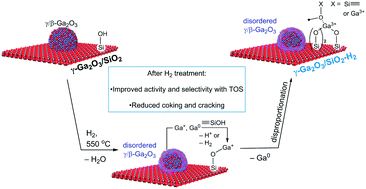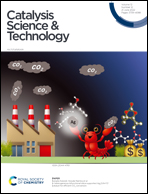Atomic-scale changes of silica-supported catalysts with nanocrystalline or amorphous gallia phases: implications of hydrogen pretreatment on their selectivity for propane dehydrogenation†
Abstract
This work explores how H2 pretreatment at 550 °C induces structural transformation of two gallia-based propane dehydrogenation (PDH) catalysts, viz. nanocrystalline γ/β-Ga2O3 and amorphous Ga2O3 (GaOx) supported on silica (γ-Ga2O3/SiO2 and Ga/SiO2, respectively) and how it affects their activity, propene selectivity and stability with time on stream (TOS). Ga/SiO2–H2 shows poor activity and propene selectivity, no coking and no deactivation with TOS, similar to Ga/SiO2. In contrast, the high initial activity and propene selectivity of γ-Ga2O3/SiO2–H2 decline with TOS but to a lesser extent than in calcined γ-Ga2O3/SiO2. In addition, γ-Ga2O3/SiO2–H2 cokes less than γ-Ga2O3/SiO2. Ga K-edge X-ray absorption spectroscopy suggests an increased disorder of the nanocrystalline γ/β-Ga2O3 phases in γ-Ga2O3/SiO2–H2 and the emergence of additional tetrahedral Ga sites (GaIV). Such GaIV sites are strong Lewis acid sites (LAS) according to studies using adsorbed pyridine and CO probe molecules, i.e., the abundance of strong LAS is higher in γ-Ga2O3/SiO2–H2 compared to γ-Ga2O3/SiO2 but lower than in Ga/SiO2 and Ga/SiO2–H2. Dissociation of H2 on the Ga–O linkages in γ-Ga2O3/SiO2–H2 yields high-frequency Ga–H bands that are observed in Ga/SiO2 and Ga/SiO2–H2 but not detected in γ-Ga2O3/SiO2. We attribute the increased amount of GaIV sites in γ-Ga2O3/SiO2–H2 mostly to an increased disorder in γ/β-Ga2O3. X-ray photoelectron spectroscopy detects the formation of Ga+ and Ga0 species in both Ga/SiO2–H2 and γ-Ga2O3/SiO2–H2. Therefore, it is likely that a minor amount of GaIV sites also forms through the interaction of Ga+ (such as Ga2O) and/or Ga0 with silanol groups of SiO2.



 Please wait while we load your content...
Please wait while we load your content...